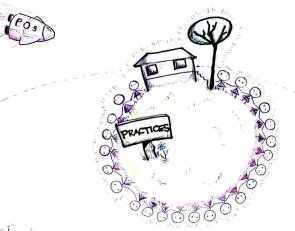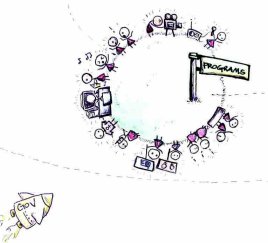With the support of the International Development Research Centre (IDRC), Isis International together with Aalochana of India, CMDI of Thailand, FemLINK Pacific of Fiji, and HELP of Papua New Guinea embarked on a research to determine the most effective communication tools used by intermediary groups in reaching grassroots women. The study was done in the context of interrogating the ICT-centric framework of development and the influx of new ICTs in gender and development work. On the assumption that access to new information and communication technologies will lead to women’s empowerment, project interventions privileged the use of new ICTs over traditional communication tools long used by intermediary groups in effecting change with grassroots communities. Are new ICTs perceived as more effective and more empowering compared to traditional communication tools?
 The three-year five-country study concluded that traditional communication tools are more useful, more accessible, more effective, and more empowering for grassroots women compared to new ICTs. The radio, popular theatre, and film were the most effective tools in the 5 Asia-Pacific countries included in the study, namely India, the Philippines, Thailand, Fiji, and Papua New Guinea. Oral communication or direct face- to-face interaction was the most empowering mode of communication between grassroots women and intermediary groups.
The three-year five-country study concluded that traditional communication tools are more useful, more accessible, more effective, and more empowering for grassroots women compared to new ICTs. The radio, popular theatre, and film were the most effective tools in the 5 Asia-Pacific countries included in the study, namely India, the Philippines, Thailand, Fiji, and Papua New Guinea. Oral communication or direct face- to-face interaction was the most empowering mode of communication between grassroots women and intermediary groups.
Underlying the effectiveness and empowering potential of any communication tool is a common denominator that resonates across the five Asia-Pacific countries studied. This shared element in the communication process is the centrality of grassroots women in determining the inter mediary group’s choice of communication tool and consequently, choice of communication strategy. It is the focus on grassroots women and what is appropriate, suitable, and yes, empowering from their own perspective and experience that leads to empowerment. The relative utility, accessibility, effectiveness, and empowering potential of each tool differ for each country, and even for each intermediary group in its unique context. But the common thread to a communication tool’s success is its har mony with the practices of grassroots women on the ground.
In this light, Isis International together with Aalochana of India, CMDI of Thailand, FemLINK of Fiji, and HELP of Papua New Guinea, propose a People’s Communications for Development or PC4D Agenda.
Proposing the PC4D Model
In accordance with the set of implications and recommendations arising from the research results, the PC4D agenda has three major spheres: (1) practices, (2) programmes, and (3) policies. Akin to the solar system, practices lie at the core while programmes and policies revolve around it in successive concentric circles, similar to planets orbiting around the sun. This analogy of the system of the planets highlights the dynamism of the three spheres. As the sphere of practices resonates with communication activities by grassroots women or people on the ground, the sphere of programmes is simultaneously busy with intermediary groups or other development actors engaged in communication projects, while the sphere of policies is likewise filled with states and other bodies setting communication policies.
Framed within the research parameters, grassroots women lie at the core of communication practices, intermediary groups in communication programmes, and states and other development bodies in communication policies. However, the key players in development may enter any sphere, thus the analogy of rockets. States, donors, and other development agencies may initiate or support programmes as well as determine or influence policies. Intermediary groups, feminist networks, and social movements may direct programmes for grassroots women and for social movements as well. They may also be engaged in their own communication practices.
As with the solar system, communication programmes and communication policies must constantly revolve around communication practices. As such, the PC4D model stresses that programmes and policies cannot be separated from what is happening on the ground. The basic assumption is that development takes place only when programmes and policies are solidly focused on community practices. Policies and programmes that are not based on the perspectives and experiences of the people in communities will not lead to the kind of development that is truly empowering to people. Hence, development must begin from the ground, must be rooted in practices, and must be determined by grassroots women, communities, and people themselves. Failure to keep people and community practices at the core leads to maldevelopment.
Isis International, Aalochana, CMDI, FemLINK, and HELP envision a development agenda that is centred on people’s communications. PC4D is a call to ensure that communication programmes and communication policies are constantly grounded on community practices. PC4D is a reminder that people are at the core of development.
Reflecting on Meaningful Impact
For the PC4D model to create any meaningful impact, it puts forward four platforms of engagement.
The PC4D model promotes the need for development projects to be grounded in the practices and everyday realities of poor and other marginalised communities.
The first area of engagement is categorised as “Gender and Development Paradigms and Communication Policy Directions.”This area refers to the ways in which the PC4D model challenges the assumptions about ICT for development (ICT4D) as a single path to development. The PC4D model advocates for multiple paths, situating the ICT4D model as one path that can possibly complement PC4D. As such PC4D is not intended to replace ICT4D, but is positioned to promote a critical approach to technology-led development. In the research project, the key issue in terms of communication policies is access: how grassroots women and intermediary groups working for grassroots women’s empowerment can access potentially empowering communication tools. If the results of the study were to enter the policy-making discourse, policy actors could ensure access, control, and ownership of new ICTs as well as mass media systems and structures by grassroots women and marginalised communities. This is the desired impact of the project in terms of policy directions.
The second area of engagement is “Politics of Traditional Communication Tools, State Inter ventions, and Donor Programmes for Grassroots Women.” This thematic area refers to the ways in which the PC4D model promotes the revaluing of traditional communication tools for development work among states and donor programmes vis-à-vis new ICTs. This area seeks to influence government and donor programmes towards supporting traditional communication tools particularly in development projects directed at grassroots women and marginalised communities. Clearly, the study revealed that it was not new ICTs but traditional communication tools that were most frequently utilised and were most effective for grassroots women’s development projects. An example of the desired impact of the project is promoting programmes such as public spaces for meetings, street theatre, public libraries, independent films, community TV, and community radio.
A particular development project, for instance, becomes empowering to grassroots women living in a specific context not only for its content but because of the medium used.
The third area of engagement is “Social Movements, Feminist Networks, Inter mediary Groups, and Communication Strategies.” This area refers to the ways in which the PC4D model seeks to include grassroots women and marginalised groups into the development agenda; as well as to enhance the communication capacities of social movements, feminist networks, and other civil society actors. Should such capacity-building programmes be promoted among development actors, it is expected that there will be a deepened understanding of the crucial role communications plays in determining the success or failure of development projects targeted at achieving grassroots women’s empowerment.
The fourth area of engagement is “Traditional Communication Tools and New ICTs as Shaping and Ref lecting Everyday Life.” This theme refers to the ways in which the PC4D model promotes the need for development projects to be grounded in the practices and everyday realities of poor and other marginalised communities. By emphasising the notion that communications both shape and reflect social realities, it is hoped that the use of traditional communication tools and new ICTs in development projects, particularly for grassroots women, will be appreciated in its complex and dynamic contexts. This area also puts attention on the interrelatedness of the communication tool or medium, its content, and its context. How a particular development project, for instance, becomes empowering to grassroots women living in a specific context not only for its content but because of the medium used. It is hoped that the PC4D model can bring development policies and programmes closer to the conditions and needs on the ground, particularly of grassroots women who remain among the most vulnerable of marginalised communities.
The model seeks to involve multiple players in the multiple spheres of development, namely policy-making bodies, development programmes, and community practices on the ground. There is no hierarchy among the spheres, but there is a core that is being advocated by the PC4D model. That core is marginalised peoples and their everyday realities.
Advocating Action
Given the findings of the study, Isis together with Aalochana, CMDI, FemLinkPACIFIC, and HELP, put forth 12 points addressed to multiple stakeholders in development work. Policy recommendations are addressed primarily to policymakers. Programme recommendations are addressed t states, donors, and other developmen actors and agencies. Recommendation for practices are addressed to socia movements, feminist networks, an intermediary groups.
Policy Recommendations
[1] Based on feminist development paradigms, policies should take into account the three types of mass media ownership: (1) private, (2) public, and (3) community. As such policies should be geared towards the creation of an enabling environment to ensure public service and community access to mass media systems and structures.
[2] In the context of existing class, caste, and racial divides as well as diverse forms of marginalisation, the state should be held accountable for its responsibility to provide access, control, and ownership of new ICTs to grassroots women and marginalised communities. For instance, the stat can provide the necessary infrastructure to allow rural communities to have access to new ICTs, subsidise costs of accessing new ICTs, create free public access to new ICTs, and ensure translation to local languages of marginalised groups.
Programme Recommendations
[3] Given that oral face-to-face communication surfaced as the strongest tool for empowering grassroots women, states, donors, and other development agencies should recognise this and support this direct and interactive mode of communication work by intermediary groups. As such, support for intermediary groups’ programmes and projects should include meeting with their constituencies for more effective communication.
[4] Given that traditional communication tools are found more effective in empowering grassroots women vis-a-vis new ICTs, states, donors, and other development agencies should support intermediary groups’ use of traditional communication tools. For instance, the provision of public spaces for meetings; funding on programs for street theatre and performing arts; the creation of public libraries and women’s resource centres; financing posters and print materials; support for independent or alternative films, community tv, and community radio; and support for translation into local languages of information for marginalised groups.
[5] Appreciating the role of intermediary groups in development work and grassroots women’s empowerment, states, donors, and other development agencies should recognise intermediary groups’ knowledge and expertise. In particular, intermediary groups’ choice of communication tools given their knowledge of what is accessible, effective, and empowering for grassroots women must be respected and supported.
[6] Recognising the need for gendered information and communication, states, donors, and other development agencies should support programmes for “gender mainstreaming” in information and communication projects. This can entail having a regular gender media officer or conducting regular gendered communication training activities for intermediary groups, government bodies, and other stakeholders.
[7] As stated by grassroots women in the focus group discussion, new ICTs are perceived as desired forms of communication but will require a steep learning curve. Recognising this need, states, donors, intermediary groups, and other development agencies should develop grassroots women’s individual and organisational capacities in the use of new ICTs.
Practice Recommendations
[8] Recognising the need to include and prioritise grassroots women’s voices in the development agenda, intermediary groups, feminist networks, and social movements should ensure their involvement in the development of communication policies and programmes. This implies the systematic inclusion of perspectives of marginalised peoples and communities in the advocacy agenda of feminist networks and social movements. This may be done through regular consultations and dialogues with grassroots communities or as mediated by intermediary groups.
PC4D advocates the problematising of the role of development communications.
[9] Recognising the importance of communication work in social activism, intermediary groups and social movements in general should develop clear communication strategies especially when working with grassroots women. This implies that communication strategies are seen as integral to social activist work and not as a supplement, “add-on,” or as a technique that is only useful for advocacy.
[10] Recognising the significance of women infocom groups and the lack of financial assistance for gendered information and communication work, feminist organisations and movements should engage in new forms of working such as intermovement dialogues and alliance-building. Feminist infocom groups can (1) popularise feminist ideas within communication organisations and other issue-based social movements on the one hand, while (2) infusing communication ideas within feminist organisations and networks.
[11] Guided by this research showing when information is empowering for grassroots women, intermediary groups should make information (1) accessible, (2) accurate, (3) transformative, (4) dialogue-based, and (5) useful, among other criteria. Accessibility means using the local language and tools appropriate for the target group whereas accuracy refers to information based on research on the ground, or data gathered from the community.
The added value of a feminist approach to development communications that is advocated by the PC4D model is for us not to generalise the conditions of women. Rather to allow the diverse realities of grassroots women to dictate the directions of development communications and shape the development agenda.[12] Guided by this research showing when communication tools are most accessible, most effective, and most empowering for grassroots women, intermediary groups should practice specificity in their choice of communication tools for effective communication. As such, intermediary groups should examine when specific types of communication tools work best for a specific purpose and target audience, including the possibility of combining traditional communication tools and new ICTs.
Imagining PC4D
The distinct nature of the PC4D model and the role it seeks to play is not in posing a new set of solutions. Rather PC4D advocates the problematising of the role of development communications. Such questioning is deemed crucial given that the new ICT phenomenon is rapidly transforming the character and operations of industries, sectors, and communities, including the development domain. If development players are to maintain a critical edge, the nature and role of communications in development cannot be taken for granted.
While the PC4D model is critical of the quick-fix approach of techno- deterministic development paths, particularly for women, it certainly does not advocate for the rejection of new ICTs nor does it see these as a hindrance to development. PC4D veers away from such binary struggles and moves towards a deepened appreciation and understanding of development communications and its complexities. That is, its historical and cultural evolution, its dynamic existence, and its unyielding power for social change.
The added value of a feminist approach to development communications that is advocated by the PC4D model is for us not to generalise the conditions of women. Rather to allow the diverse realities of grassroots women to dictate the directions of development communications and shape the development agenda.
It is always that which is seemingly straightforward and in existence for the longest time that is often overlooked and unquestioned, be they the exercise of everyday gender roles in society or the everyday communication strategies in development. PC4D asserts that should the politics of the everyday be given the attention it deserves and should the practices from the ground be allowed to take the lead, then meaningful and appropriate changes at the level of development programmes and policies can follow.
Perhaps there can be no grand development communication model, but a plurality. Still the success of diverse models must be measured in their ability to include and empower. PC4D is not the answer to development but a reminder that we must sincerely make the search.





 The
The 
 Isis Resource Center holds one of the largest feminist collections of materials in the Global South. With 40 years of publication experience, Isis holds a vast collection.
Isis Resource Center holds one of the largest feminist collections of materials in the Global South. With 40 years of publication experience, Isis holds a vast collection.